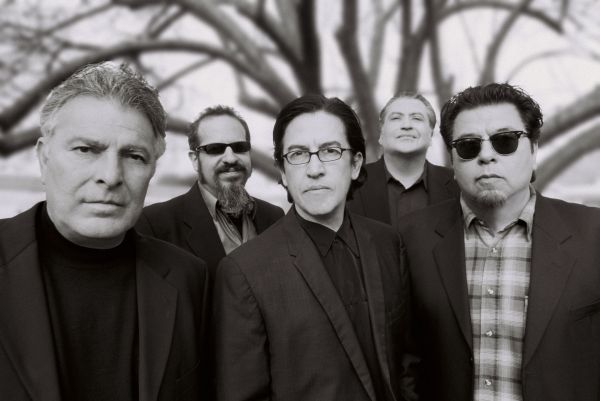
The final two installments of PBS’s “Latin Music USA” take up the East L.A. scene and the rise of divas like Jennifer Lopez and Shakira. Oscar Garza, veteran Los Angeles journalist and former editor of Tu Ciudad magazine, reviews the documentary, which will air Monday on most PBS stations including KCET in Los Angeles. Last week, he discussed the first two installments of the series.
1959 was shaping up as a pivotal year for young Mexican-American musicians who were trying to break into mainstream rock ‘n’ roll. In California, 17-year-old Ritchie Valens burst out of Pacoima with a string of hit singles. And in Texas, 22-year-old Freddy Fender hit the charts with a bluesy version of “Wasted Days and Wasted Nights.”
But everything suddenly changed: that same year, Valens died in the plane crash that also killed Buddy Holly. And a few months later, Fender went to prison for three years on a trumped up marijuana charge.
Those stories lead off “The Chicano Wave,” the third episode in the PBS series, “Latin Music USA,” which seeks to establish the influence of various Latin genres in American popular music history. This installment hits all the landmarks: the mid-’60s East L.A. scene that produced Cannibal & the Headhunters; the politicization of bands such as El Chicano and Tierra in California, and Little Joe y La Familia in Texas; the early Mexican roots explorations of Los Lobos, and more.
But because much of this ground was covered less than a year ago in another PBS documentary, “Chicano Rock! The Sounds of East Los Angeles,” it all seems slightly superfluous. To be sure, there are some nice moments, such as 87-year old Bob Keane still getting choked up when he talks about the tragic end of his protegé Valens. And fellow octogenarian and record producer Huey P. Meaux talking about how he found a down-and-out Fender washing cars after his prison stint.
And there’s a great moment in the segment on Linda Ronstadt, when she talks about hoping to include a Spanish-language song on her first album in 1969 with the Stone Poneys – a nod to the Mexican music she grew up hearing in Tucson. The record company wouldn’t hear of it. Ronstadt went on to become the biggest-selling female pop singer of the ’70s, and eventually got her revenge in 1987 when she recorded “Canciones De Mi Padre.” Her record label’s execs were skeptical, but by then Ronstadt had plenty of power. With over two million copies sold in the U.S., “Canciones” still stands as the biggest selling non-English language album in American record history.
Perhaps because of the previous “Chicano Rock” doc and its emphasis on California, this show spends quite a bit of time on the Texas scene. The familiar tragic story of Selena Quintanilla is recounted. The Tejano music queen was on the verge of a mainstream breakout in 1995 when she was gunned down just a couple of weeks shy of her 24th birthday by the deranged former head of her fan club. Journalist Joe Nick Patoski observes: “She was going to be the next Madonna.”
The episode ends with the phenomenal success story of Los Tigres del Norte, the band of Mexican immigrants who have come to represent the experience, hopes and dreams of countless immigrants here.
But given that this show is being seen nationally, it’s too bad the filmmakers focused on the usual suspects and didn’t choose to give time to the new generation of artists who are re-defining Chicano music while still maintaining their ethnic pride. Bands like the multi-ethnic Ozomatli or artists such as Lila Downs are nowhere to be found. And there’s certainly no place anywhere in this series for someone like the neo-folkie Devendra Banhart, who was born in Texas and raised in Venezuela, and who has included Spanish-language songs on each of his critically-acclaimed albums.
But at least “The Chicano Wave” has its moments. The same can’t be said for the concluding episode, “Divas and Superstars.” Largely focused on the Latin pop hype that started in the late 1990s, the installment focuses on the well-known stories of Ricky Martin, Marc Anthony, Jennifer Lopez and Shakira. And there’s time spent on the rise of Latin hip-hop and reggaetón, replete with a waste of attention given to a Puerto Rican politician who crusades against the lewd perreo dance that accompanies the music. The filmmakers fail to point out how this is just the latest example of grown-ups objecting to suggestive music and dance.
The only bright spot in the final episode is listening to Lin-Manuel Miranda, the Tony Award-winning composer of the Broadway musical, “In the Heights.” Miranda effectively encapsulates the Latin-American experience and the role that music plays in traversing two cultures.
His comments are almost compelling enough to make you forget that you’ve just watched public tax dollars being spent to tout the dubious musical artistry of Jennifer Lopez.
“Latin Music USA” concludes tonight at 9 on KCET in Los Angeles, and on many other PBS stations.
*Photo of Los Lobos courtesy Los Lobos.




Send A Letter To the Editors